My trip today was going to take around 12 hours depending how much, if any, actual sailing I would get in. Because it is prudent to get to any new anchorage in the daylight, I decided to launch at sunup. Weighing anchor was uneventful, and I even got to try out my automatic anchor wash setup, which worked great!1
Another pleasant surprise that happened at exactly the same time I was weighing anchor and testing out my new system was a women in an inflatable dinghy coming toward the boat. I thought it a bit unusual for anyone to be out so early in a dinghy on Memorial Day, but was too busy to really think about it. But as the autopilot slowly motored Serendipity out of the anchorage while I stowed the anchor on the bow, I realized that it was Robin in the dinghy! She had seen the lights on my mast change from anchor light (required to be on a night when anchored) to running lights (required to be on when underway at night). She realized I must be departing and decided to see me off! It was a lovely surprise. So we motored together for a minute or two before saying goodbye, then I turned west to head out the Manatee River into the Gulf of Mexico for the trip down to Boca Grande.
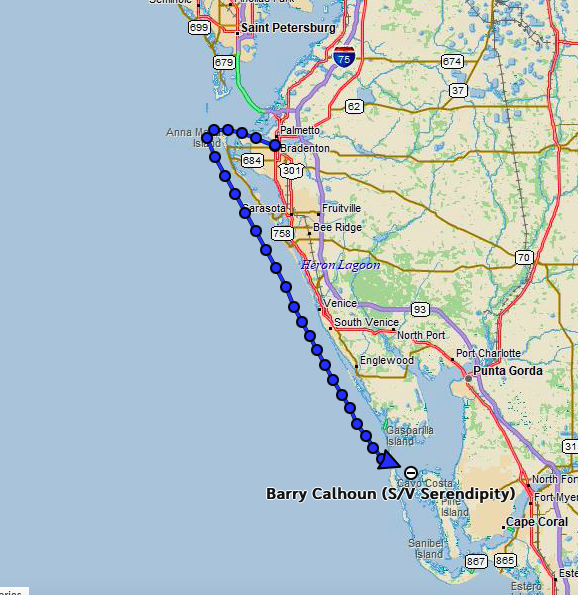
The forecast called for initially calm winds but possibly picking up enough to sail in the afternoon. Sure enough, around 1 pm, the winds built a little out of the southwest to about six knots, which was enough for me to hoist the Genoa, Main, and Mizzen and get 3.5 to 4 knots of out of them. It was great to finally turn off the engine and hear only the peaceful sounds of the wind through the rigging and the water on the hull as we slid quietly along.
This leg gave me a chance to play with my “new” radar. When I bought the boat in 2021, the previous owner swore that the radar, mounted on the mizzen mast, worked, even though he hadn’t reconnected it after having the mast down to paint it. He said he didn’t feel it was worth the trouble as he never saw the need for radar sailing in the Bahamas.
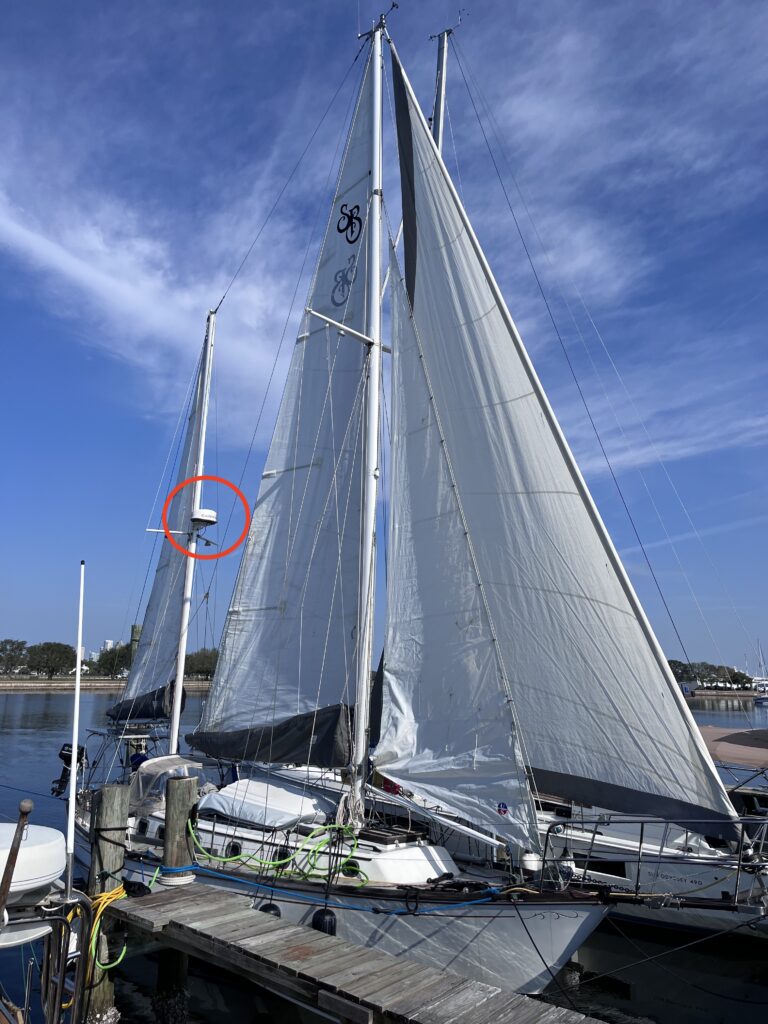
I was rather astounded, having recognized the many benefits of radar long ago in my Coast Guard flying career. He seemed to be under the impression that it was only for seeing big ships and didn’t seem to realize that it also could pick up smaller boats (or even small objects in the water if it were tuned right), thunderstorms, and perhaps most importantly, land and even aids to navigation for night time and fog. So, I had wanted to get it rewired since owning the boat, and finally did that a few weeks prior to launching (with Nicholay’s valuable help). And, true to the previous owner’s word, it worked!

Although I had played with it a bit in Tampa Bay, this trip gave me a chance to see how far away I could actually “paint” different size boats with the radar and even play with the weather stuff as there were initially a few showers in the distance that had built up over night but were slowly dissipating. It worked pretty well. What a great tool!
At one point during the day, directly ahead of me, I saw what looked like a crab pot float. Although my hull is not as susceptible as most to getting tangled up on those, they are best avoided when possible. But something about this didn’t look right; it was the wrong shape. As we got closer, I realized that it was a sea turtle floating with its head above the water.
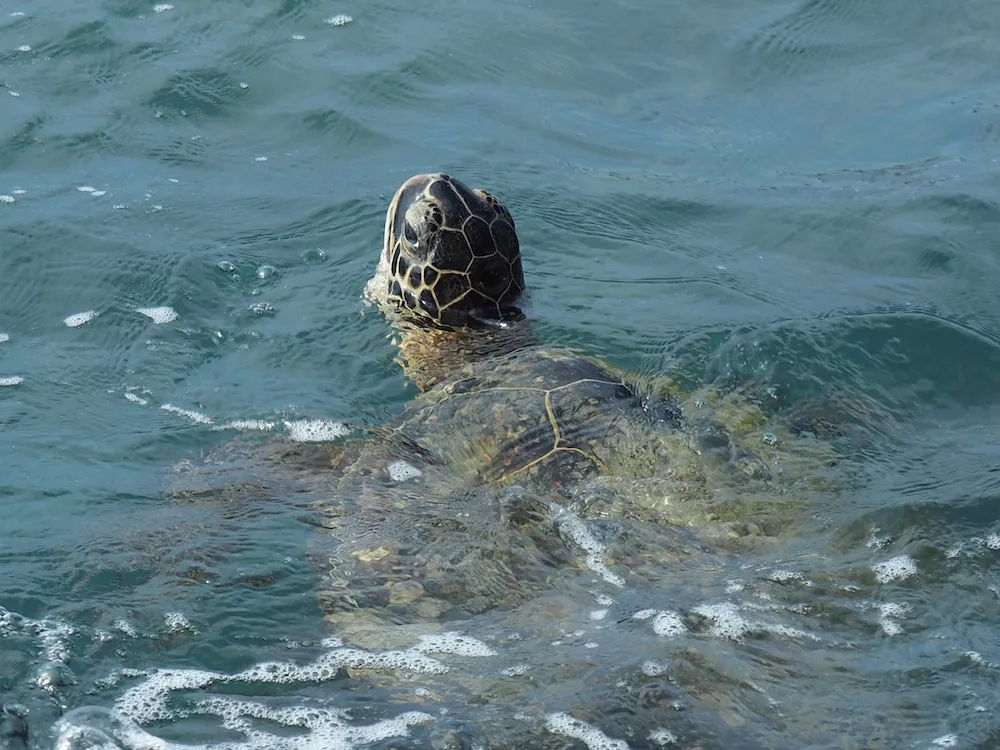
As we got to about 10 feet away, it suddenly turned, saw the boat, and dove quickly deep. I didn’t think turtles could swim that fast! Lol.
As forecast, the winds veered (shift around clockwise) to the northwest throughout the afternoon, requiring me to occasionally adjust the sail trim2. But, by 4:30 pm, the winds had died down again, so I cranked the motor back up and continued south at a more noisy, but quicker pace. (I typically motor between 5 and 6 knots.
Boca Grande (“Big Mouth” in Spanish) is so named because it is a large pass between Gasparilla Island to the north and Cayo Costa (meaning small coastal island) to the south and is the main entrance to Charlotte Harbor. Due to massive shoaling (shallow water) on the north side of the entrance, the channel actually heads quite a distance offshore to the southwest. Coming from the north as I was, this meant having to actually go past the actual pass by about 3 miles, then turn into the channel and motor another 4 miles to get to the entrance. At six knots, the meant more than an additional hour of motoring, just to get through the pass!
But luckily, I noticed a little comment on my app about another, informal channel that squeezed between the shoal area and the west side of Gasparilla island, named “Swash Channel” by the locals. Comments left by various boaters agreed depths in this “channel” didn’t get below 8 feet, which would make it deep enough for Serendipity (which had a draft of 5′ 8″ when loaded). So, I headed for the pass, following the directions in the comments and keeping a careful eye on both depth sounders, and didn’t have an issue! What a great discovery!
It being Memorial Day weekend, there were tons of people recreating on the beaches of Gasparilla Island as I passed by, and many people fishing off boats in the channel. But the anchorage was completely empty so I picked a random spot, dropped the hook around 7:00 pm, and enjoyed a nice sunset before a light dinner then checking the weather to come up with a plan for tomorrow.
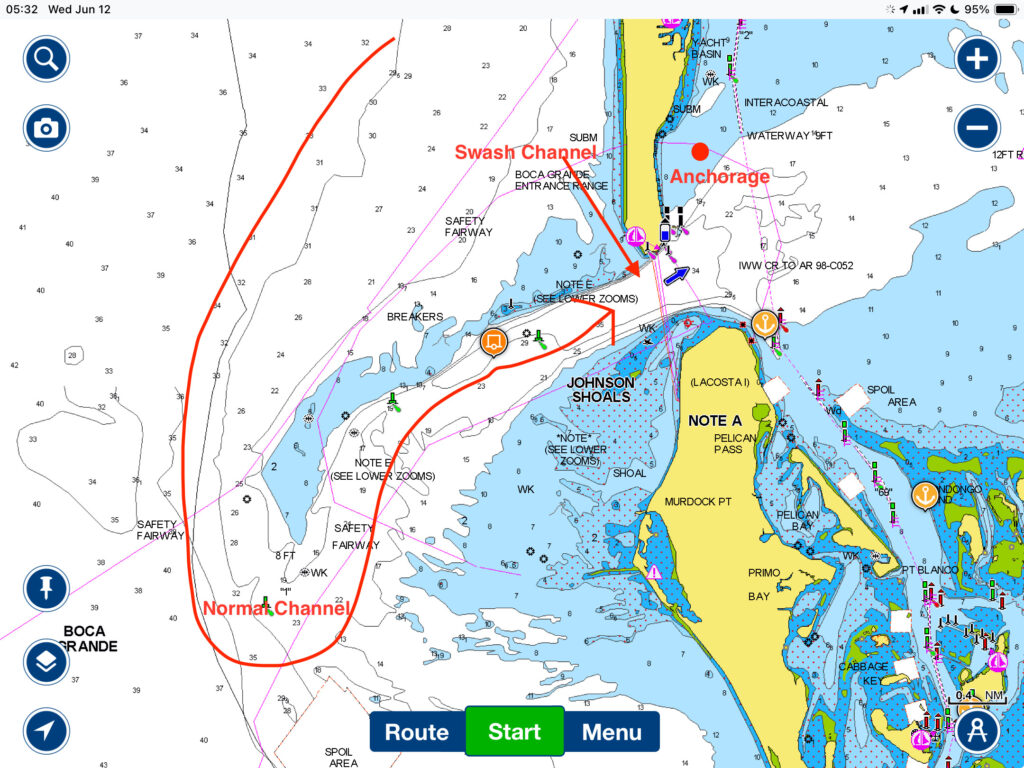
I basically had two options on how to proceed. My first was to keep hopscotching down the coast, hugging the coast and pulling into an anchorage each night. However, as in a lot of Florida, anchorages suitable for a boat with a 5’8″ draft were limited. I would have to make a long day’s journey to Marco Island, followed the next day by Little Shark River in the Everglades, thence to Marathon in the Keys. Or, my second option was to do an all-nighter and head straight for Marathon which would take between 25 and 30 hours depending on how much I sailed.
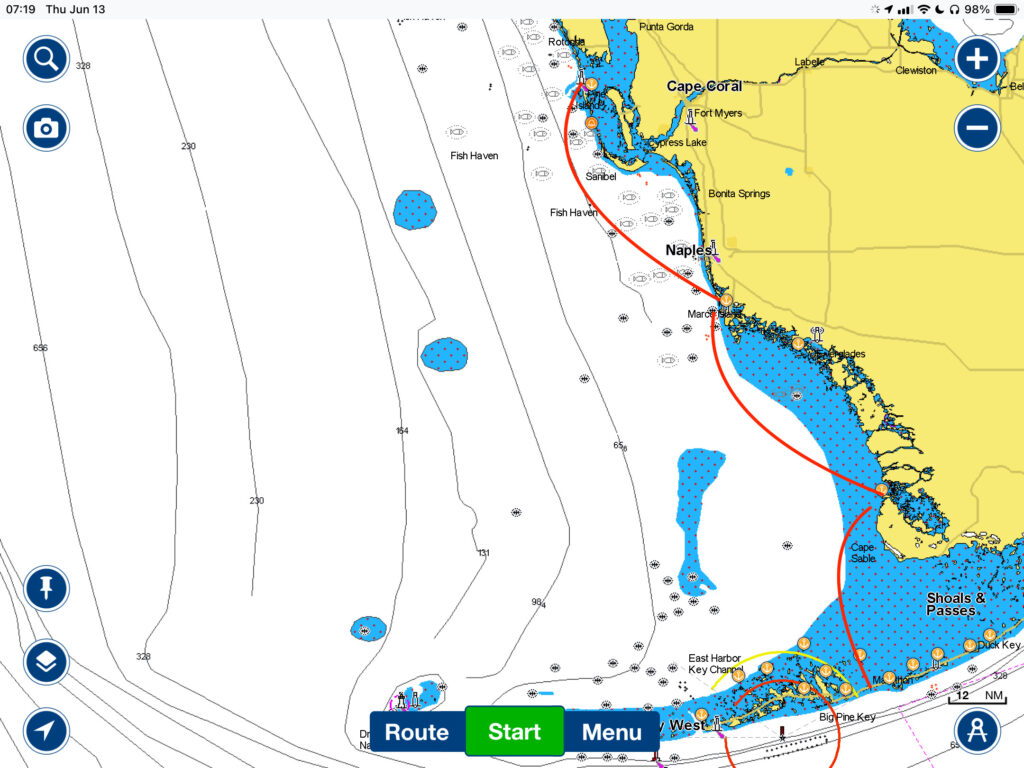
The forecast tomorrow was calling for a repeat today, with little wind until the afternoon, then some sea breeze until around 10 pm which should give me a chance to sail a bit, then calm wind throughout the night. Because the weather was forecast to be benign, and because I was really wanting to get out of the oppressive Florida heat, I decided on the second option. But, after single-handing all night and being very tired and needing rest, I didn’t want to arrive in Marathon in the middle of the day when my cabin temperatures would be in the 90s to try to sleep. That just wasn’t going to happen. I wouldn’t realistically be able to sleep until probably 10 pm when the temperatures finally reached the low 80’s. However, I also didn’t want to get there too late, because I needed to get fuel in Marathon, and they closed at 5:00 pm. So the plan was to wake up late so as to arrive around 4:00 pm or so, top off fuel, then anchor off of Vaca Key and get a good night’s rest before continuing up the Keys to Miami.
So, with the knowledge that I wouldn’t have to leave the next morning till about 10 am, I hit the sack without needing to set an alarm.
- My “ground tackle” consists of a primary anchor (which is a 55 lb Rocna), 200 feet of 10 mm chain, and 320 feet of 3/4″ 8-plait line. If my detailed calculations are correct, this system should be adequate for winds at anchor up to 60 knots. The anchor is mounted on the forward most anchor roller on the bowsprit and the rode (chain and line) leads through my electric windlass to an anchor locker below deck.
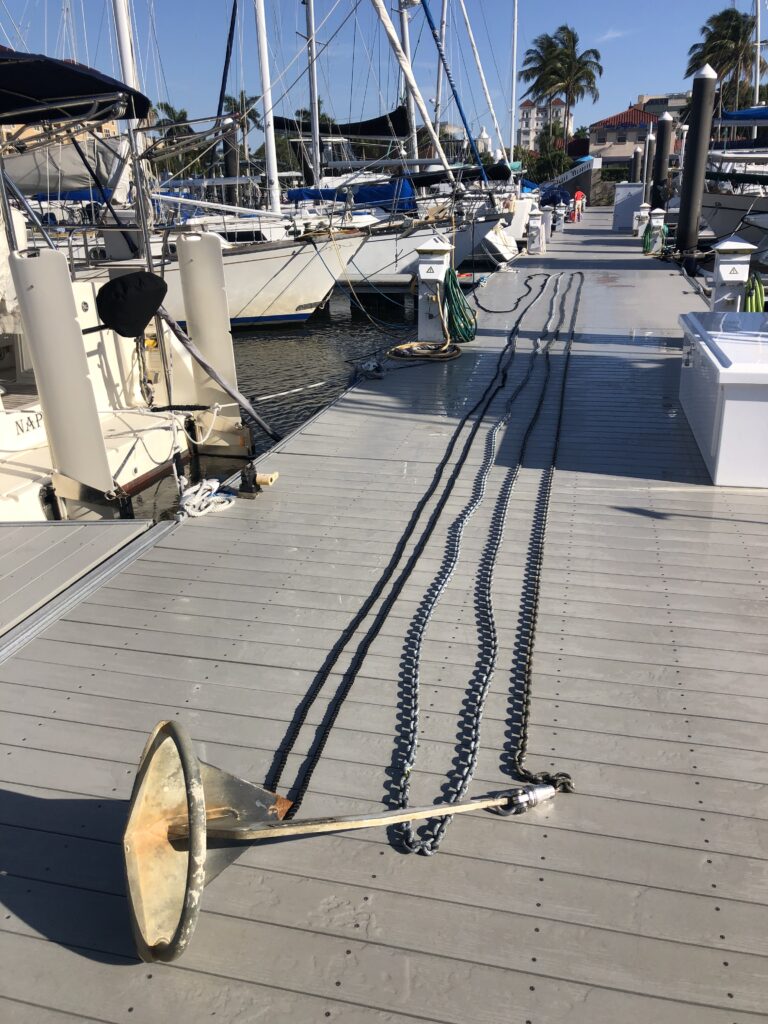
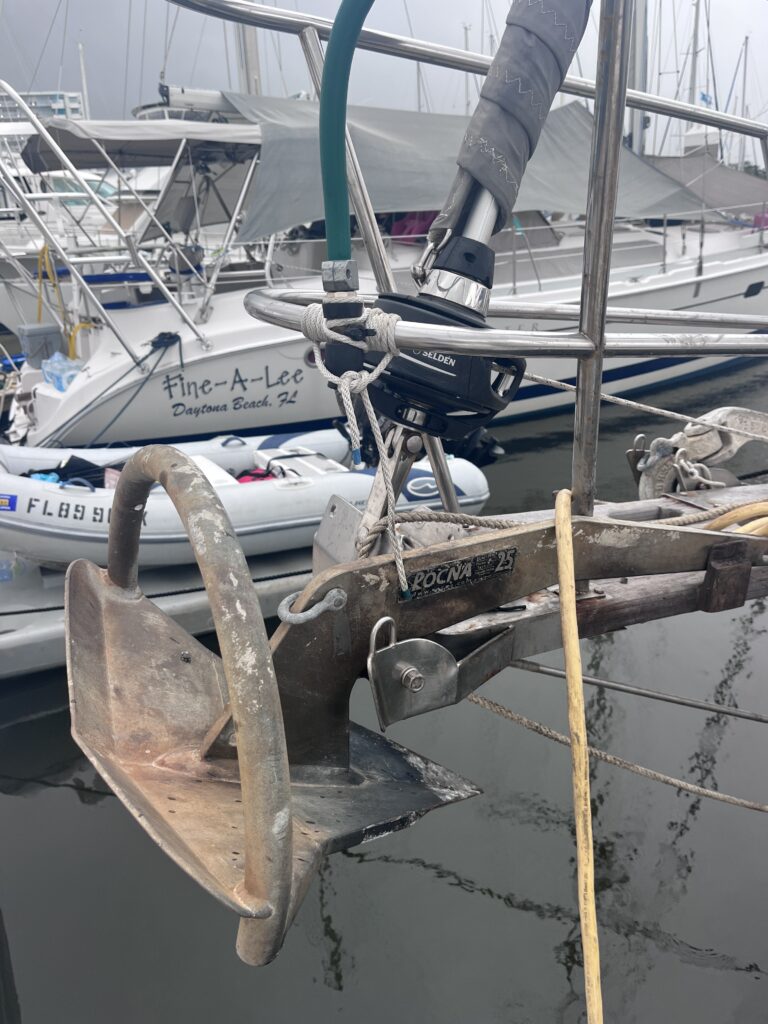
My primary anchor, a 55 lb Rocna, mounted on the port side of the bowsprit.
I also have a secondary anchor on the after anchor roller on the bowsprit, a 35-lb CQR anchor. Attached to it is 120 feet of 8 mm chain and 300 feet of 5/8″ line. Although the chain and line would be adequate for winds up to about 50 knots, the anchor itself is designed for a 28- to 32-foot boat (mine is 38′), so is a bit too small. However, it was the only anchor that I had which would fit on my secondary anchor roller. Although this set of ground tackle also leads to an anchor locker below deck, it does not have a windlass. That side of the bowsprit had been serviced by the boat’s original heavy-duty Ideal windlass, but it failed years ago. I have partially removed it, but have not yet replaced it with another windlass. So, should I need to deploy my secondary anchor, it will be by hand (which another reason I didn’t opt for a larger secondary anchor).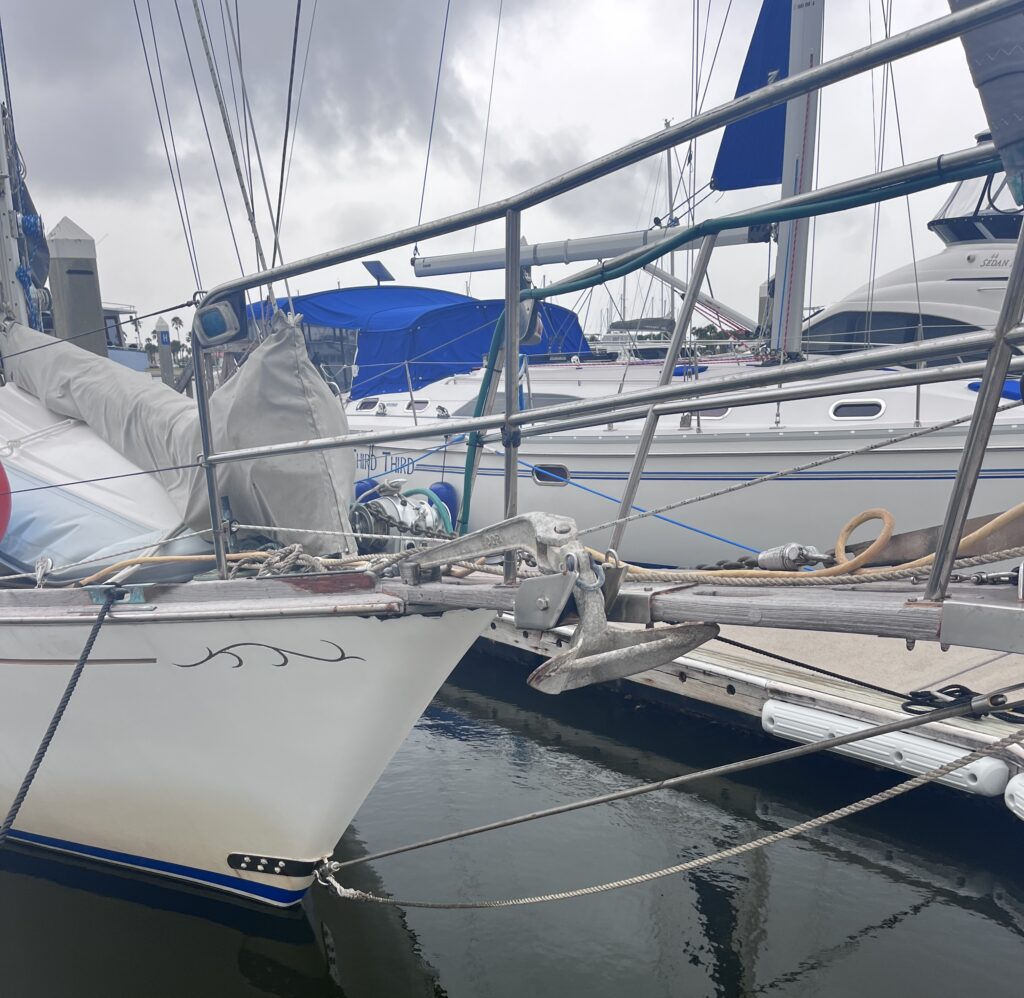 My secondary anchor, a 35 lb CQR mounted on the starboard side of the bowsprit.
My secondary anchor, a 35 lb CQR mounted on the starboard side of the bowsprit.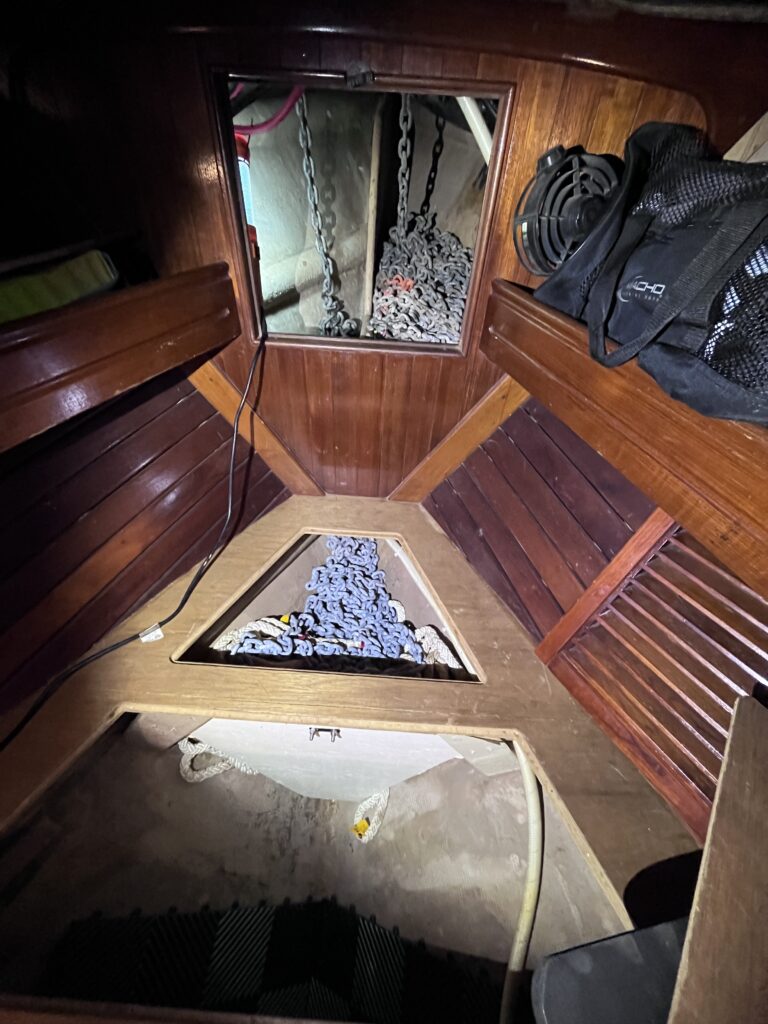
Anchor locker with primary chain on the left and secondary on the right. Primary chain overflow and 3/4″ line in front.
Cruisers like using a lot of chain in their rode for a few reasons: It is very strong and it protects against rough bottoms like coral or rock (where line would chafe). But the main reason is because of the weight. All anchors hold best would pulled horizontally. As soon as the rode starts angling upwards, the anchor starts losing its effectiveness. The chain is so heavy that for many feet after the anchor it lays on the bottom, ensuring a more horizontal pull on the anchor, and maximizing the chance that it will “set” and hold well.
Weighing anchor (bringing it in) can be a messy affair, depending on the bottom conditions. In pure sand, the rode and anchor typically come up clean. (Sand also provides very good holding and is easy to set an anchor in, so is one of the more preferred bottom surfaces.) At the other extreme is mud, which often smells horrible and will cling tenaciously to the chain and anchor. If this isn’t rinsed off somehow before bringing the rode into the anchor locker below decks, it can end up making the boat smell (as well as making a mess on deck).
My boat came with a deck wash fitting which had been rigged to an electrip pump below. This was connected to a through-hull in the bottom of the boat. When it is time to retrieve the anchor, one need only open the seacock on the through hull to provide access to salt water, turn on the pump, attach a short hose to the fitting on the foredeck, and, voila, a way to spray down the rode and anchor as it comes aboard.
This system works well if there is more than one person aboard. In most weighing-anchor situations, there is one person driving the boat to move the boat slowly toward the anchor as the second person up on the bow reals in the rode. That person can also be hosing down the rode as it comes in. But that doesn’t work for me, being single handed. I can’t drive the boat and be up front hosing down the chain as it comes in. Instead, I “permanently” attached the hose and nozzle on the pulpit (railing that surrounds the bowsprit) so that it aims down at the anchor roller. As the chain comes up and over the roller, it gets sprayed with salt water, hopefully knocking off all the stinky mud and other stuff. It also would aim at most of the anchor when it finally made it all the way up (although a more effective way to clean the anchor is to just drag it through the water for a bit before finally retrieving it all the way).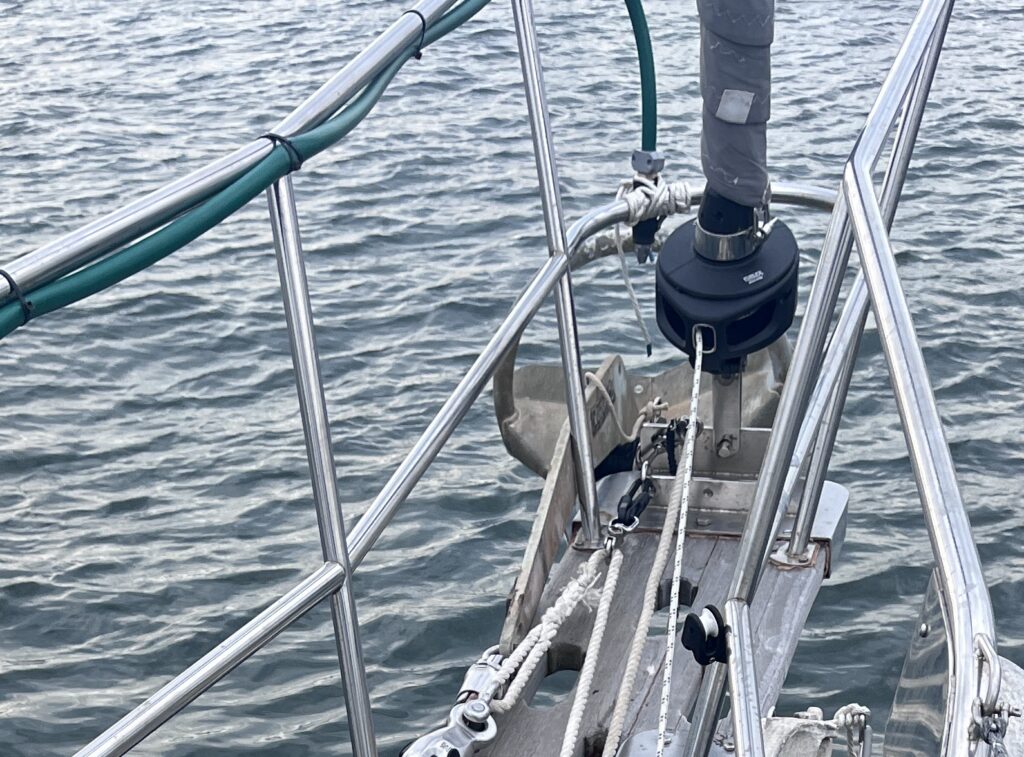 Green hose strapped to pulpit rail is ground tackle rinse system.
Green hose strapped to pulpit rail is ground tackle rinse system.
That was the theory, anyway, but I hadn’t had the chance to test the system until this morning when the bottom in the Manatee River turned out to be very muddy indeed. As soon as I saw that, I opened the valve, turned on the pump, and watched the saltwater spray very effectively rinse the mud off chain as it came up. Success! ↩︎ - “Trimming” sails means adjusting them to the most efficient angle to the wind. When racing, this is a constant activity as there are always tiny wind shifts and racers want to get every ounce of speed they can. Cruisers, on the other hand, aren’t as meticulous and will retrim sails when the wind has shifted enough to slow the boat down noticeably. Trimming is always started with the forward-most sail because the flow off that sail affects the sails behind it. ↩︎